
Ferns are easy-care houseplants that create a tropical ambience. Some species are suitable for extreme locations that get little light. Ferns only need an increased water supply during the heating period.
In a nutshell
- Ferns don't like direct sun
- Exotic species tend to like it warm and do not tolerate temperatures below 15 °C well
- Substrate should usually be slightly damp
- some fern species are very frugal and hardly need any additional fertilization
- Fern species develop well in commercially available houseplant soil
Table of contents
- Fern species from F – G
- H – N
- P – T
- frequently asked Questions
Fern species from F – G
squirrel fern (Davallia mariesii)
The squirrel fern is closely related to the harefoot fern. However, it is significantly smaller and its rhizomes are more reminiscent of a squirrel's tail.

- Location: light to half-shade, morning or evening sun, winter sun
- substrate: potting soil
- Fertilization: Use slow release fertilizer
- Castings: always keep slightly moist, reduce watering in winter
maidenhair fern (Adiantum raddianum)
The maidenhair fern is the most popular of the ferns. The filigree leaves can reach a length of up to 60 centimeters in an optimal location.
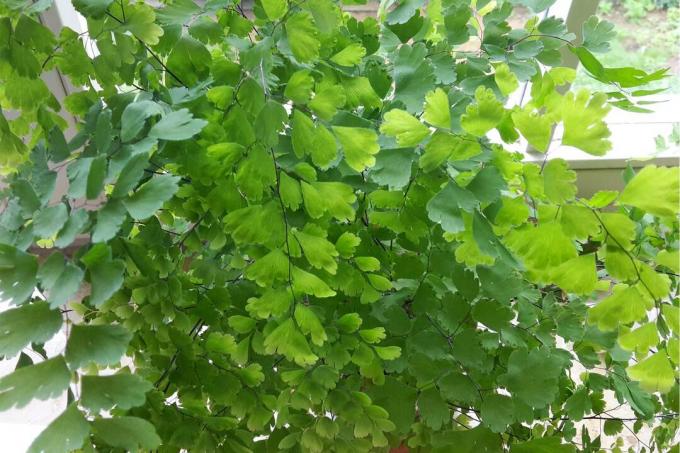
- Location: light to semi-shady, no direct sun
- substrate: nutrient-poor potting soil, orchid soil, low mineral content
- Fertilization: from April to September every four weeks, use fertilizer for green plants
- Castings: needed high humidity, set up water bowls, use lime-free water, spray occasionally, always keep the substrate slightly moist, avoid dry periods
antler fern (Platycerium bifurcatum)
The antler-like leaves of the staghorn fern can reach a length of up to 90 centimeters. It should be kept in traffic lights, because that's where the forked leaves come into their own.
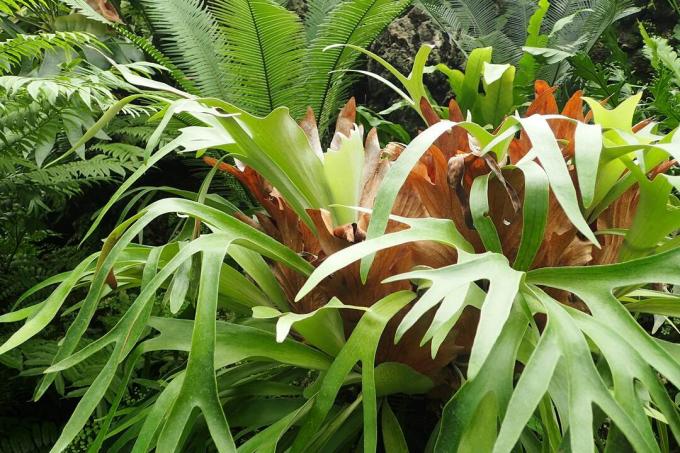
- Location: bright, warm, no direct sun, at least 20 °C
- substrate: Orchid soil, coarse leaf soil mixed with peat and pieces of bark
- Fertilization: every 6 weeks during the growth phase, liquid fertilizer for green plants
- Castings: Water thoroughly, allow to dry until next watering, only rarely water in winter, use low-lime water
goldenspotted fern (Phlebodium aureum)
With its curled leaves, the gold-tipped fern provides variety among houseplants. Due to its large leaves, it has very good air-purifying properties.

- Location: light to semi-shady, no direct sun
- substrate: humus potting soil, slightly acidic pH value
- Fertilization: Spring – autumn, green plant or houseplant fertilizer
- Castings: always keep moist, avoid waterlogging, spray regularly, water more moderately in winter
Tip: The golden spotted fern also ensures good air in the office. It can even filter out pollutants from the room air.
H – N
Harefoot Fern (Davallia bullata)
The harefoot fern has noticeably glossy leaves compared to many other species. It multiplies via rhizomes that look like rabbit feet and can grow beyond the pot.
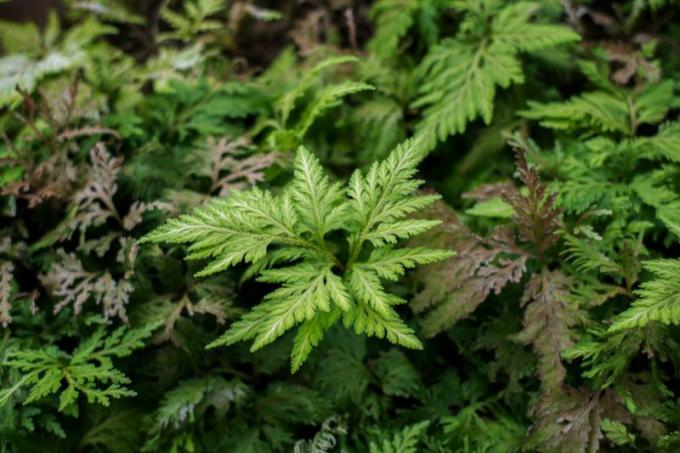
- Location: bright to semi-shady, morning or evening sun
- substrate: Potting soil, cactus soil, orchid soil
- Fertilization: Moderately, 2 - 3 times a year with green plant fertilizer, alternatively use long-term fertilizer
- Castings: always keep moist, avoid waterlogging, spray regularly, water more moderately in winter
heart fern (hemionitis arifolia)
The heart fern is proof that ferns don't always have to have pinnate leaves. Due to its unusual heart-shaped leaf shape, it is an eye-catcher in rooms with alternating humidity such as the bathroom.
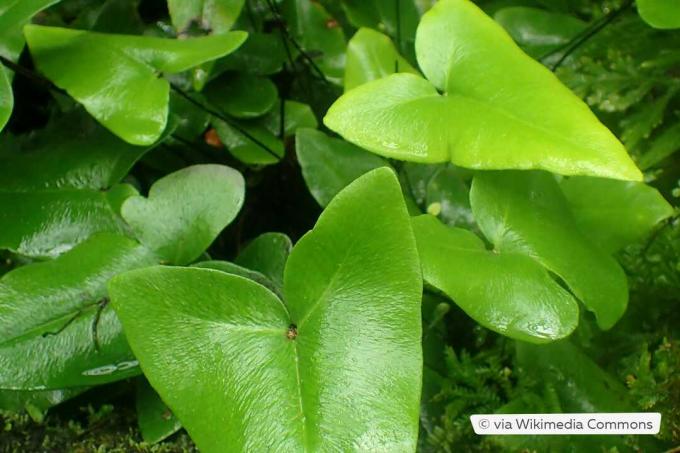
- Location: light to semi-shady, no direct sun
- substrate: commercial houseplant soil
- Fertilization: not mandatory
- Castings: Water regularly and moderately, allowing the soil to dry out in between
leatherleaf fern (Rumohra adiantiformis)
The leatherleaf fern has very robust and leathery leaves. He prefers the most unpopular corners of the house, which tend to be darker.

- Location: shady
- substrate: Commercial house plant soil, humic, permeable
- Fertilization: not mandatory
- Castings: water moderately
moss fern (Selaginella martensii)
The moss fern is occasionally sold cheaply on New Year's Eve as a lucky charm. Moss ferns are only for experts because they are difficult to care for, which is why the lucky charms often only have a short lifespan.
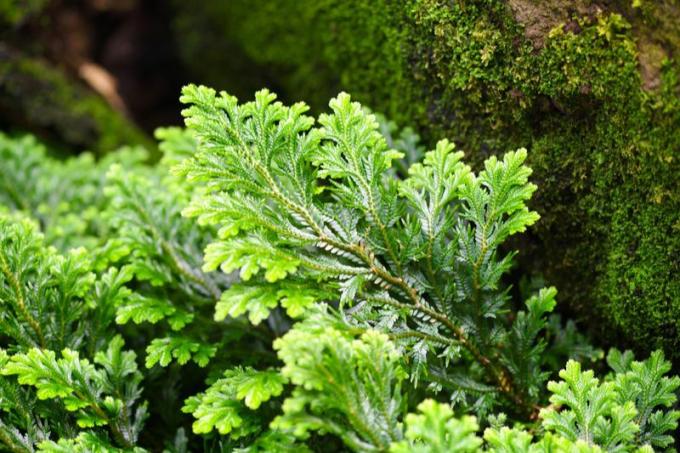
- Location: light to semi-shady, avoid direct sun
- substrate: Houseplant soil, herb or vegetable soil
- Fertilization: April – September, fertilize moderately
- Castings: keep evenly moist, not dripping wet, roots rot quickly
Tip: The propagation of moss fern is very easy, because it forms aerial roots under optimal conditions. Shoots with several roots are potted and grow within a short time.
nest fern (Asplenium nidus)
With its large leaves, the nest fern is perfect for collecting moisture from the air. An ideal location is the bathroom with high humidity.

- Location: bright, no direct sun, humidity of at least 60%
- substrate: humus rich, indoor plant soil
- Fertilization: Spring - summer, every 4 weeks with liquid fertilizer for green plants
- Castings: always slightly damp
A notice: In order for the nest fern to develop evenly, the pot should be turned every 14 days. This prevents one-sided growth.
P – T
pellet fern (Pellaea rotundifolia)
The Pellefarn is very robust, because even the dry air from the heating does not bother it in winter. It is ideal for beginners who are looking for their first fern for greening.

- Location: sunny to semi-shady
- substrate: Potting soil mixed with clay granules
- Fertilization: April – September, fertilize moderately
- Castings: Water moderately, allow to dry again and again
Tip: The Pellefarn can be propagated by division when it has become too large for the pot. To do this, the stick is carefully pulled apart with your hands in the spring and the two parts are repotted.
tree fern (Pteris cretica)
With its multicolored leaves, the mulberry fern is always an eye-catcher. Not only its coloring is special, but also the shape, which is vaguely reminiscent of the staghorn fern.

- Location: Shady to semi-shady, maximum morning or evening sun
- substrate: Mixture of pot and house plant soil, cactus soil
- Fertilization: fertilize moderately, April – September
- Castings: keep evenly moist, allow the surface to dry
sword fern (Nephrolepis exaltata)
The sword fern is ideal for adding green accents to areas in rooms that only get little light. With its overhanging fronds, it is also well suited as a traffic light plant hanging from the ceiling.

- Location: light to semi-shady, no direct sun, ideal for east and west windows
- substrate: nutrient-rich and permeable, potting soil mixed with perlite
- Fertilization: April - September weekly with green plant fertilizer, October - March once a month
- Castings: keep constantly moist, avoid waterlogging, tolerates short periods of drought
Tarantula Fern (Humata tyermannii)
The tarantula fern gets its name from the shoots that look like hairy spider legs. However, the exotic beauty needs constant temperatures above 15 °C.
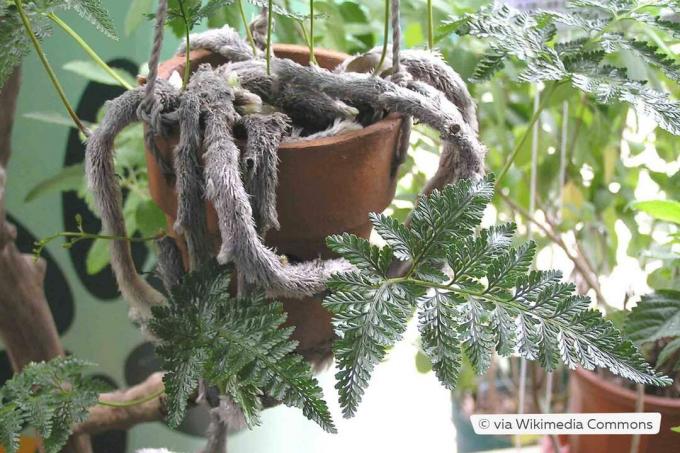
- Location: light to semi-shady, ideal for a rainforest terrarium
- substrate: commercial substrate for indoor plants
- Fertilization: once a month with green plant fertilizer
- Castings: very high water requirement, always water thoroughly
frequently asked Questions
Ferns can sometimes grow sprawling if they have an optimal location and the right care as a houseplant. In general, shortening is not recommended, as damaged leaves can die off completely. If individual leaves have become too long, remove them at the base. Cut off a maximum of three to four leaves and give the fern enough time to recover. You can remove dead leaves at the base at any time.
All fern species appreciate being sprayed with water from time to time. This will make the Leaf surface free of dust and they can absorb moisture from the air. A fern should be sprayed once every one to two weeks, especially if it is cultivated as a houseplant. To do this, use lime-free and temperate water. Hard water can lead to unsightly lime spots on the leaves, which in turn can close the stomata.
Like other houseplants, ferns are repotted in the spring. A time when fertilization is usually started is ideal, because this way you can postpone the time of the first fertilization, since the fresh substrate offers sufficient nutrients. When repotting, make sure that the fern has enough space to spread, because they only form large clumps under optimal conditions.



